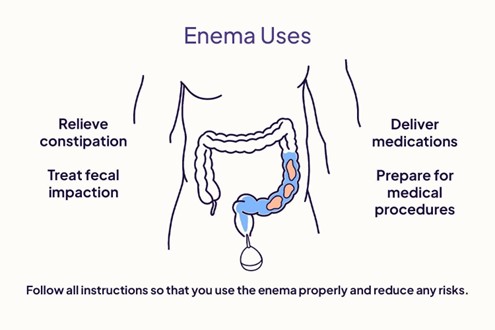An oil retention enema is prescribed for a hospitalized client. The practical nurse (PN) should administer the enema solution at which temperature?
The solution temperature should be determined by the client’s comfort level
The temperature of the enema is unrelated to the enema’s effectiveness
The solution should approximate the client’s body temperature (98°F or 36°C).
The temperature should be higher (110°F or 43°C) than the client’s body temperature
The Correct Answer is C
- An oil retention enema is used to soften the stool and lubricate the rectum, making it easier to pass the stool. It is usually oil-based and contains 90-120 ml of solution³.
- The temperature of the enema solution affects the effectiveness and comfort of the procedure. If the solution is too hot or cold, it can cause pain, cramps, or damage to the rectal tissue³. If the solution is too warm, it can also stimulate peristalsis and cause the client to expel the enema before it has time to work⁴.
- The ideal temperature for an enema solution is close to the client’s body temperature, which is around 98°F or 36°C. This temperature ensures that the solution is comfortable and does not cause adverse reactions³⁴.
Option A is incorrect because the client’s comfort level may not reflect the optimal temperature for the
enema.
Option B is incorrect because the temperature of the enema does affect its effectiveness and safety. Option D is incorrect because the temperature is too high and can cause harm to the client.

Nursing Test Bank
Naxlex Comprehensive Predictor Exams
Related Questions
Correct Answer is ["B","C"]
Explanation
Choice A reason: "I may experience urinary incontinencE." This statement does not indicate the need for additional teaching because it is truE. Urinary incontinence is a common symptom of MS due to nerve damage affecting the bladder control.
Choice B reason: "I should not exercise because this may trigger an exacerbation." This statement indicates the need for additional teaching because it is falsE. Exercise is beneficial for people with MS as it can improve strength, balance, mobility, fatigue, mood, and quality of lifE. Exercise does not cause or worsen MS relapses.
Choice C reason: "I should alternate the eye patch every other day to help with the double vision." This statement indicates the need for additional teaching because it is not recommendeD. Eye patching is not an effective treatment for double vision caused by MS, as it can impair depth perception, increase eye fatigue, and delay recovery. Eye patching should only be used temporarily and under medical supervision.
Choice D reason: "I may experience visual disturbances." This statement does not indicate the need for additional teaching because it is truE. Visual disturbances are common in MS due to inflammation or damage of the optic nerve or other parts of the visual pathway. Visual disturbances can include blurred vision, reduced color vision, pain in the eye, and loss of vision.
Choice E reason: "I need to check the water temperature before I take a batH." This statement does not indicate the need for additional teaching because it is truE. People with MS may have impaired sensation and temperature regulation, which can increase the risk of burns or hypothermia when exposed to hot or cold water. Checking the water temperature before bathing can prevent injury and discomfort.
Correct Answer is B
Explanation
Choice A reason: Limiting fluid intake to prevent incontinence is not the highest priority intervention for this client because it can cause dehydration, urinary tract infections, or kidney stones, which can worsen the client's condition and quality of lifE. The client should be encouraged to drink adequate fluids and empty their bladder regularly.
Choice B reason: Providing regular perineal care to prevent skin breakdown is the highest priority intervention for this client because it can prevent infection, irritation, and ulceration of the skin around the genital and anal areas, which can cause pain, discomfort, and complications. The client should be kept clean and dry, and use barrier creams or pads as needeD.
Choice C reason: Administering hypotonic IV fluids is not an intervention for this client because it can cause fluid overload, hyponatremia, or cerebral edema, which can endanger the client's health and safety. The client does not need IV fluids unless they are dehydrated or have other indications.
Choice D reason: Teaching Kegel exercises to strengthen the pelvic floor is not an intervention for this client because it can be ineffective or harmful for clients with reflex incontinence, which is caused by loss of voluntary control over bladder contractions due to spinal cord injury. The client may benefit from other interventions such as bladder training, medication, or surgery.
Whether you are a student looking to ace your exams or a practicing nurse seeking to enhance your expertise , our nursing education contents will empower you with the confidence and competence to make a difference in the lives of patients and become a respected leader in the healthcare field.
Visit Naxlex, invest in your future and unlock endless possibilities with our unparalleled nursing education contents today
Report Wrong Answer on the Current Question
Do you disagree with the answer? If yes, what is your expected answer? Explain.
Kindly be descriptive with the issue you are facing.
